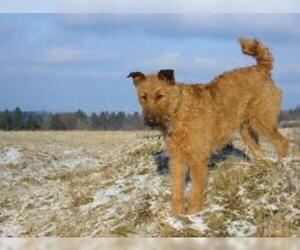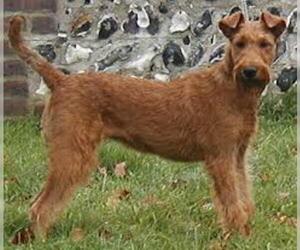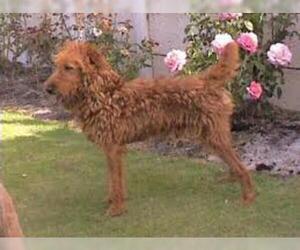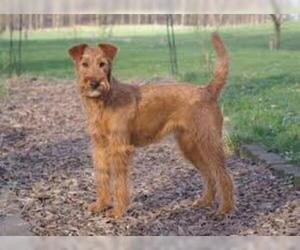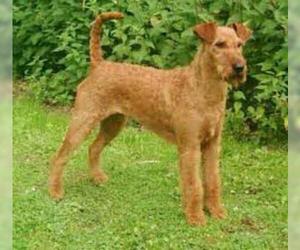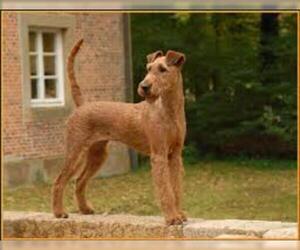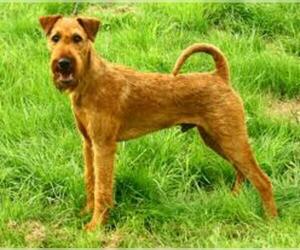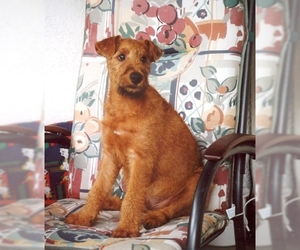
All about Irish Terrier dog breed
A.K.A. :Irish Red Terrier, Red Terrier, Irishman's Dog, Tarrytown Terror, Irish Rough-Haired Terrier, Red Dog, Irishman's Terrier, Terrier Irlandais, Irischer Terrier, Tosaigh Rua, Red Rough, Red Devil
Size
Grooming requirements
Exercise requirements
Good with other dogs
Watchdog ability
Energetic
Training requirements
Playful
Affectionate
Good with other pets
Good with children
Good with strangers
Winter
Summer
Healthiness
Protective
Life Span
| Pure Breeds | Member |
| Breeds A - Z | I |
| Breeds by Group | Terrier |
| Breeds by Trait | High Stamina Dog Breeds Hypoallergenic Low Shedding Smartest Dog Breeds |
| Overview: | The Irish Terrier is a spirited and courageous breed originating from Ireland, historically valued as a versatile farm dog for vermin control and guarding. Known for their distinctive fiery red, wiry coat, they are a medium-sized dog, typically weighing between 25-27 pounds and standing around 18 inches tall. Beneath their charming, scruffy exterior lies a bold and confident temperament, often described as "daredevil" yet deeply affectionate with their families. They possess high energy levels and require regular exercise and mental stimulation to prevent boredom. While generally good with children and suitable for family life, their strong prey drive means early socialization is crucial, especially around smaller pets. They can adapt to apartment living if their exercise needs are consistently met. Health-wise, Irish Terriers are a robust and generally healthy breed, with a life expectancy of 13-15 years. However, like all breeds, they can be predisposed to certain conditions, though none are particularly prevalent, making them a relatively low-maintenance companion in terms of health. |
F.A.Q.
All You Need to Know About the Irish Terrier Breed
The Irish Terrier, a spirited and courageous breed originating from Ireland, is known for its distinctive wiry red coat and fearless personality. These medium-sized dogs are often described as "daredevils" but possess an affectionate and loyal temperament with their families, making them excellent companions. Physically, they are strong, agile, and athletic, requiring a good amount of exercise to stay happy and healthy. While intelligent and trainable, their independent streak means consistent, positive reinforcement is key. They can be suitable for families with older children who understand how to interact with dogs, but early socialization is crucial. Apartment living can work if their significant exercise needs are met, including daily walks and playtime. Their wiry coat requires moderate grooming, including regular brushing and occasional hand-stripping to maintain its texture. Generally healthy, potential owners should be aware of conditions like cystinuria and hyperkeratosis. With proper care, an Irish Terrier brings boundless energy and love into a home.Irish Terrier Weight: The average weight for an adult Irish Terrier is between 25-27 pounds. These dogs are known for their sturdy, medium build. Typically, there's little significant difference in healthy weight between male and female Irish Terriers, both falling within this range. Potential owners looking for the average size and healthy weight for an Irish Terrier can expect a dog around 27 pounds at maturity.
Wondering about the Irish Terrier height? You've come to the right place! When considering an Irish Terrier, understanding their typical size is key.
The average height of an Irish Terrier, measured at the shoulder, falls in a consistent range for this energetic breed. Most adult Irish Terriers will stand between 18 to 19 inches tall.While there isn't a significant difference in how tall is an Irish Terrier based on gender, males often tend to be at the upper end of this range, while females might be slightly closer to the 18-inch mark. However, individual genetics play a large role, and you can find both male and female Irish Terriers throughout this spectrum.This "average size" makes the Irish Terrier a medium-sized dog, well-suited for various living situations, provided they get adequate exercise. They're not too small to be delicate, nor too large to be overwhelming. So, if you're looking for a dog with a manageable yet sturdy build, the Irish Terrier's consistent 18-19 inch height makes them an excellent choice!The Irish Terrier colors are primarily red, ranging from a bright wheaten red to a deeper mahogany red. This is the only color officially recognized by major kennel clubs like the AKC for AKC recognized Irish Terrier colors. You will not find rare coat types or exotic Irish Terrier variations such as blue, lilac, merle, chocolate, brindle, fawn, cream, or white in purebred Irish Terriers accepted by these clubs. Any Irish Terrier advertised with these non-standard colors is likely not a purebred, or its lineage may include other breeds, which can affect temperament and health. When comparing Irish Terrier colors for adoption or purchase, remember that the classic red is the breed standard.
The Irish Terrier personality is a delightful blend of courage, loyalty, and spirited charm. These dogs are often described as "daredevils" with hearts of gold. They are incredibly loyal to their families, forming strong bonds and acting as vigilant, though not aggressive, protectors. Their temperament of Irish Terrier is generally friendly and outgoing, especially with people they know. While not typically demanding of constant attention, they thrive on being part of family activities. They are quite sociable and enjoy interactions.Regarding adaptability to apartment living, while active, Irish Terriers can adapt well if provided with sufficient daily exercise and mental stimulation. They are highly intelligent and need to be kept engaged.With children, they can be wonderful companions, especially if raised with them. Their playful and robust nature often aligns well with active kids, but supervision is always recommended, as with any breed.Concerning other pets, Irish Terriers have a strong prey drive, a characteristic of many terrier breeds. This means they may not always get along with smaller, non-canine pets like cats, unless introduced carefully and at a young age. With other dogs, especially those of the same sex, they can sometimes be assertive, so early socialization and consistent training are crucial. They generally do best as the sole dog or with a compatible companion of the opposite sex.
Irish Terrier Temperament & PersonalityThe Irish Terrier temperament is a captivating blend of courage, charisma, and loyalty, making them an excellent companion dog. Known for their fiery spirit and endearing nature, they are generally friendly and outgoing with their human families. While not overly clingy, they are deeply devoted and form strong bonds, exhibiting remarkable loyalty. Their intelligence and quick wit make them highly trainable, though they can possess an independent streak, hinting at a touch of stubbornness.Regarding sociability, Irish Terriers are often described as "big dogs in small packages." They thrive on interaction and can be quite playful. When it comes to adaptability to apartment living, they can do well if their exercise needs are consistently met. Daily walks, playtime, and mental stimulation are crucial to prevent boredom. They are moderately active indoors but truly shine with outdoor adventures.Behavior with children is generally good; they are often patient and protective, but like with all breeds, supervision is essential, especially with very young children, to ensure respectful interaction. They can be boisterous in play. Their behavior with other pets, particularly other dogs, can be a mixed bag. They possess a strong prey drive and historically were bred to work alone, so early and consistent socialization is vital for peaceful coexistence with other canines and smaller pets. They may be prone to challenging other dogs, especially those of the same sex. They are generally not overly sensitive but respond best to positive reinforcement training methods rather than harsh corrections. Their keen intelligence means they pick up on cues quickly, but their strong will requires a confident and consistent handler.
Irish Terrier Care: Essential Daily Maintenance & Health TipsCaring for an Irish Terrier involves several key aspects to ensure a happy, healthy companion. Their distinctive wiry coat requires moderate grooming: weekly brushing is essential to prevent matting and remove loose hair, with professional stripping recommended every 3-4 months to maintain coat texture and health. Unlike some breeds, they are not prone to excessive shedding.Despite their energetic appearance, Irish Terriers are a low-energy dog breed indoors, but still require daily exercise to stay fit and mentally stimulated. Aim for at least 30-60 minutes of varied activities, including walks, playtime, and short training sessions. They thrive on human interaction and can be prone to boredom if left alone for extended periods, leading to destructive behaviors.Dietary considerations for your Irish Terrier should focus on high-quality dog food appropriate for their age, weight, and activity level. Avoid overfeeding to prevent obesity, a common health concern. Regular monitoring of their weight and body condition is crucial for long-term health.Specific health checks include dental care; daily brushing or dental chews are recommended to prevent plaque buildup and gum disease. Their skin can be prone to skin issues, so regular checks for redness, irritation, or bumps are important.Irish Terriers are generally robust, but like all breeds, they can be susceptible to certain conditions. Responsible breeders screen for common genetic issues. How to care for an Irish Terrier also means being aware of their overall well-being, including regular veterinary check-ups for preventative care. With consistent daily maintenance and attention to their unique needs, your Irish Terrier will be a joyful and devoted member of your family.
The Irish Terrier activity level is moderate to high. These spirited dogs possess a surprising blend of energy and calm. They thrive on regular Irish Terrier exercise needs, which typically include at least 45-60 minutes of vigorous activity daily. This can be broken into several sessions and might involve brisk walks, runs, or engaging playtime in a securely fenced yard. They particularly enjoy interactive games like fetch and will happily chase balls or engage in short, energetic bursts of play.Despite their energetic bursts, how active are Irish Terrier can be deceiving; they are not hyperactive. They are known for their ability to balance these short periods of intense energy with long periods of rest and relaxation, making them excellent companions indoors once their exercise needs are met. This means they are suitable for active families who enjoy outdoor activities, but they can also adapt to slightly less active households as long as their daily exercise requirements are consistently met.It's important to note that while some terrier breeds can have brachycephalic limitations, the Irish Terrier is *not* a brachycephalic breed and does not suffer from the breathing difficulties associated with a shortened snout. Therefore, their exercise is not limited by this anatomical constraint, allowing them to enjoy their physical activities without this specific concern. However, like all dogs, they should not be over-exercised in extreme heat or humidity. Providing mental stimulation through training and puzzle toys is also crucial to keep their intelligent minds engaged.
Breed Breakdown: What Experts Say About the Irish Terrier
Rating the "Size" trait of the Irish Terrier: 5The Irish Terrier is a medium-sized breed, typically standing between 18 to 20 inches tall and weighing around 25 to 27 pounds. Their body structure is athletic and robust, but not bulky. Compared to other companion dogs, they are clearly larger than toy breeds like Chihuahuas or Pomeranians, but significantly smaller than giants like Great Danes or Saint Bernards. They fall squarely in the middle ground, making them a moderately sized dog. This makes them well-suited for apartment living, provided they receive adequate exercise, as they aren't so large that they'd feel cramped. Their moderate size also makes them good travel companions, fitting comfortably in most vehicles and not being overly cumbersome in public spaces. Households with space constraints would find them manageable, as they don't demand vast amounts of room simply due to their physical dimensions, unlike truly large breeds.
I would rate the Irish Terrier's grooming requirements a 7 out of 10.While they are not as demanding as some long-haired or heavily-coated breeds, they are certainly not a wash-and-go dog. Their wiry, double coat requires regular hand-stripping, typically every 8-12 weeks, to maintain its texture, color, and protective qualities. Skipping this will result in a soft, dull coat that sheds more and loses its characteristic appearance. Beyond stripping, weekly brushing is necessary to remove loose hair and prevent matting, though shedding is generally low with proper stripping. Ear cleaning and nail trimming are standard for most breeds and should be done regularly. They don't typically have skin folds or excessive drooling, so those concerns are minimal. They aren't particularly prone to skin issues or allergies, but a healthy diet and regular grooming contribute to overall skin health. Compared to many companion dogs that simply need regular brushing and occasional trips to a professional groomer for a clip, the Irish Terrier's need for specialized hand-stripping makes them moderately high-maintenance.
I'd rate the Irish Terrier's "Exercise Requirements" at a 7.While not in the same league as a Border Collie, the Irish Terrier is a lively and energetic breed with a working dog heritage. They thrive on daily activity and mental stimulation, going beyond simple potty breaks. They need at least 30-60 minutes of vigorous exercise each day, which can include brisk walks, jogging, off-leash play in a secure area, or even moderate hikes. Their terrier instincts mean they enjoy chasing and digging, so interactive games are highly beneficial. They are athletic and agile, making them good candidates for dog sports like agility or earthdog trials, which also fulfill their need for mental engagement. Without sufficient exercise, Irish Terriers can become bored, destructive, and even prone to nuisance barking. They don't have brachycephalic limitations, allowing them to engage in sustained movement without significant respiratory concerns, though common sense regarding extreme heat should always be applied. They are definitely not a "couch potato" breed and will require consistent, structured routines to stay healthy and mentally stimulated, preventing them from developing unwanted behaviors.
I'd rate the Irish Terrier's "Watchdog Ability" at a 9.They are exceptionally alert and highly vigilant, making them excellent household watchdogs. Their keen senses mean they readily pick up on unfamiliar sounds or the presence of strangers, often before their human companions. While not excessively barkers, they will definitely use their voice to signal anything they perceive as out of the ordinary, and it's a confident, deterrent bark. Their strong territorial instincts mean they are protective of their home and family. While not aggressive by nature, they possess a fearless and resolute spirit, and they won't back down from what they perceive as a threat to their household. They are definitely capable of providing meaningful early warnings and their presence alone can be a deterrent; they are far from a passive companion in this regard.
I would rate the "Good with Other Dogs" trait of the Irish Terrier a 3 out of 10.While not inherently aggressive, the Irish Terrier is known for its strong personality, independent nature, and historical background as a vermin hunter and, at times, a formidable participant in dog sports. This often translates to a low tolerance for perceived disrespect from other canines and a tendency towards dominance and assertiveness, especially with dogs of the same sex. They are known to be scrappy and won't back down from a challenge. While early and extensive socialization can certainly help, they generally require careful and supervised introductions to unfamiliar dogs, and their compatibility with different sizes and energy levels is highly dependent on the other dog's temperament and the Irish Terrier's individual personality. They are not a breed that typically thrives in canine company in a free-for-all sense and often prefer to be the sole canine focus in a household, or at least the clear leader. Multi-dog households can work, but require experienced owners, careful management, and a good understanding of canine social dynamics to prevent conflict. They are much more likely to coexist peacefully with dogs they have grown up with and are familiar with, but even then, owners need to be vigilant about potential squabbles.
I would rate the "Energetic" trait of the Irish Terrier a 9 out of 10.The Irish Terrier is a breed brimming with vivacity and a zest for life, earning them the nickname "daredevils" among terriers. They are naturally highly active dogs with impressive endurance, capable of long walks, vigorous play sessions, and participation in various canine sports. Their playfulness is legendary; they thrive on interaction and can be perpetual motion machines when engaged. This breed has a significant need for physical stimulation and mental engagement to prevent boredom and destructive behaviors. They excel in activities like agility, earthdog trials, flyball, and even extended hiking or running with their owners. Compared to many other companion dogs, the Irish Terrier is far from laid-back; they require a consistent outlet for their boundless energy.Importantly, the Irish Terrier is not a brachycephalic breed. They possess a well-proportioned muzzle and open nostrils, which means their anatomy does not inherently impede their stamina or exercise tolerance in the way it would for a flat-faced breed. This allows them to effectively regulate their body temperature and breathe freely during strenuous activity, further contributing to their high energy and endurance levels.
I'd rate the Irish Terrier's "Training Requirements" at a 7.While intelligent and capable of learning, their inherent Irish Terrier traits push them towards the more demanding end of the spectrum. They possess a strong will and a charming stubbornness, often questioning the necessity of a command if it doesn't align with their current agenda. Their attention span can be short-lived for repetitive tasks, requiring engaging and varied training sessions to prevent boredom. Responsiveness to commands is excellent when they perceive a benefit or are highly motivated, but less so when they're distracted by something more interesting (like a squirrel!). Consistency is paramount; any lapse will be exploited, as they are quick to learn what they can get away with. Positive reinforcement, especially with food or their favorite toy, is highly effective, but must be paired with firm, clear, and consistent boundaries. This breed is not particularly beginner-friendly in terms of training and generally benefits from experienced handling and structured routines to channel their intelligence and drive productively, preventing unwanted behaviors from taking root.
I would rate the Irish Terrier's "Playful" trait a 9 out of 10.This breed is remarkably spirited and inherently fun-loving. They possess a high activity level and thrive on interaction, consistently seeking out games and engaging with their human companions. Irish Terriers are well-known for their attention-seeking antics, often using their intelligence and charm to initiate playtime. Their response to toys is enthusiastic and they're quick to engage in a game of fetch or tug. Overall, their daily lives are filled with an infectious enthusiasm, making them a naturally spirited companion dog that is far from laid-back compared to many other breeds.
I would rate the Affectionate trait of the Irish Terrier a 9 out of 10.Irish Terriers are incredibly loving and people-oriented dogs, often referred to as "velcro dogs" due to their strong desire for human companionship. They thrive on affection and are deeply loyal to their families. While they might not be the most obvious lapdogs for their size, they will constantly seek proximity to their loved ones, often leaning against them, resting their head on a lap, or following them from room to room. They are highly sensitive to their owner's emotions and will readily offer comfort or join in the general mood of the household. Their independence often manifests in their feisty spirit and desire for adventure, but it never overshadows their profound need for connection and adoration from their human companions. They truly blossom when integrated into family life and given ample attention and affection.
I'd rate the "Good with Other Pets" trait of the Irish Terrier a 4 out of 10.While Irish Terriers can, with extensive and consistent early socialization and training, learn to tolerate other pets, they are generally not considered naturally "pet-friendly." Their strong prey drive, bred into them for vermin control, means that cats and smaller animals often trigger an instinct to chase and potentially harm. They also tend to be dominant with other dogs, particularly those of the same sex, and can exhibit resource guarding tendencies if not managed carefully from a young age. Coexisting peacefully in a multi-pet household with an Irish Terrier typically requires significant supervision, ongoing training, and a deep understanding of the breed's natural instincts, rather than an expectation of inherent sociability.
The Irish Terrier rates a 6 out of 10 for "Good with Children."While inherently affectionate and loyal to their families, the Irish Terrier's boisterous and energetic nature, combined with a strong prey drive, means they aren't universally child-friendly without significant effort. They are playful and can be incredibly entertaining companions for older, respectful children who understand how to interact with a dog. However, their high energy can be overwhelming for very young children, and their independent streak and tendency to be vocal (barking) might not be ideal for a noisy household with toddlers. They are generally tolerant of handling from their own "pack" but can be less patient with clumsy or overly enthusiastic interactions from unfamiliar or very young children. With consistent training and early socialization, especially in a home with children, they can learn appropriate boundaries. Supervision is key, particularly with younger kids, to ensure both the dog and children are safe and happy. They are not naturally gentle in the way some retriever breeds are, often requiring a firm but fair hand and clear expectations to thrive in a family setting.
I'd rate the "Good with Strangers" trait of the Irish Terrier a 4.While not inherently aggressive, the Irish Terrier is a fiercely loyal and protective breed, primarily devoted to its family. They are known for their strong "terrier" personalities, which often translate to a reserved or even aloof demeanor with unfamiliar adults. They are not naturally outgoing and welcoming to strangers; instead, they tend to be watchful and discerning. While a well-socialized Irish Terrier can learn to tolerate or even be politely indifferent to guests, their instinct is not to be overly friendly or gregarious. They are more likely to observe strangers with a critical eye, and their protective instincts can manifest as barking or an assertive presence if they perceive a threat. Extensive and consistent socialization from a young age is crucial to ensure they are comfortable rather than wary in public or guest-filled environments, as their natural inclination is not towards open sociability with those outside their immediate circle.
I would rate the Irish Terrier's winter tolerance at a 6. They possess a dense, wiry double coat which offers good insulation and some protection from the elements, but it's not thick enough to make them truly resilient in severe cold. Their lean, muscular build means they don't have a lot of body fat for extra warmth, and their medium size makes them more susceptible to heat loss than larger breeds. Their mesocephalic (proportionate) head shape isn't a factor in cold sensitivity. While they can generally enjoy outdoor activities in moderately cold climates, they are at a higher risk of hypothermia in prolonged exposure or very low temperatures compared to breeds with thicker coats or more body mass. They do require some special care during winter months compared to other companion dogs, particularly those with very short or thin coats, but also in comparison to very heavily coated or large breeds. For instance, in freezing temperatures or icy conditions, they would benefit from a warm coat or sweater for walks, and their outdoor time should be monitored to prevent overexposure. Unlike breeds built for extreme cold, they shouldn't be left outside for extended periods in harsh winter weather.
I would rate the Irish Terrier's "Summer" tolerance at a 7.While not brachycephalic, which immediately grants them an advantage over breeds like Pugs or Bulldogs in heat regulation, Irish Terriers are still active, energetic dogs with a dense double coat. This coat, while protective, can trap heat during intense activity or prolonged exposure to high temperatures. They possess a good ability to regulate body temperature for a canine, but like all dogs, they are susceptible to heatstroke if overexercised or left in hot environments without access to shade and water. Their recommended outdoor activity levels are high, even in moderate summer temperatures, but these must be significantly curtailed during peak heat. They definitely require special care in summer months compared to many other companion dogs, particularly those with thinner coats or a more sedentary disposition. While they don't necessarily need constant climate control indoors, they absolutely need to be protected from direct sun and heat during the hottest parts of the day, with outdoor exercise limited to early mornings or late evenings.
I would rate the Irish Terrier's "Healthiness" trait as a 9 out of 10.Irish Terriers are generally considered a remarkably robust and healthy breed, standing out for their resilience compared to many other companion dogs. They boast an impressive life expectancy, often living into their early to mid-teens, which is a testament to their overall good health. While no breed is entirely free of potential issues, Irish Terriers are not prone to the widespread or debilitating genetic problems seen in some other breeds, such as severe joint problems like hip and elbow dysplasia, widespread breathing difficulties, or a high incidence of specific cancers. Responsible breeding practices have largely focused on maintaining this inherent hardiness, and diligent breeders actively screen for conditions like hyperkeratosis (corns on the feet), a hereditary skin condition that, while manageable, is something to be aware of. They are generally low-maintenance from a health perspective, not requiring extensive specialized care beyond standard preventive veterinary check-ups, a balanced diet, and regular exercise. Their energetic nature keeps them fit, and their hard wiry coats are relatively easy to maintain. Their strong health makes them a truly excellent choice for owners seeking a generally robust and enduring canine companion.
I'd rate the "Protective" trait of the Irish Terrier a 7 out of 10.Irish Terriers are excellent watchdogs due to their inherent alertness and keen senses. They are quick to notice anything out of the ordinary and will readily bark to alert their owners to the presence of strangers or unusual activity. This territorial instinct, coupled with their unwavering loyalty to their family, makes them very effective at signaling potential threats. While they are bold and fearless, they are generally not aggressive without reason. They are more likely to deter an intruder through their persistent barking and confident demeanor rather than direct attack. They possess a strong protective instinct towards their loved ones, placing them firmly in the category of a companion dog capable of offering meaningful protection through their vigilant watchfulness and willingness to stand their ground. They will certainly make their presence known and are not shy about defending their household with a loud, assertive display.
I would rate the "Life Span" trait of the Irish Terrier an 8 out of 10.The Irish Terrier is generally considered a long-lived breed compared to many other companion dogs. Their average life expectancy typically ranges from 12 to 15 years, with many individuals living well into their late teens. This longevity is supported by a relatively robust health profile; they are not plagued by a wide array of severe, life-shortening genetic health issues common in some other breeds. While they can be prone to certain conditions like hyperkeratosis (a skin condition) and occasional allergies, these are rarely fatal or significantly impact lifespan if managed. Responsible breeding practices further contribute to their health, focusing on good genetic diversity and screening for known predispositions. With proper nutrition, exercise, and veterinary care, an Irish Terrier has an excellent chance of enjoying a long and healthy life.
Irish Terrier Dogs for adoptionSee all dogs for adoption
Irish Terrier BreedersSee all breeders
Similar Dog Breeds for Irish Terrier
Breed Mixes of Irish Terrier
Quick Breed Selector 0 - not important, 1 - smallest, 10 - largest
Variants & Mistakes :Irish Terier, Irsh Terrier, Irish Terrer, Irish Terrior, Irsh Terier, Irish Terirer, Irsih Terrier, Irrish Terrier, Iris Terrier, Irish Terir, Irh Terrier, Irish Terryer, Irush Terrier, Irish Terriere, Irisih Terrier, Irsih Terier, Irsh Terryer, Irish Terriar, Irris Terrier, Iris Terryer, Irish Terrir, Irsh Terrer, Irish Terriour, Irsih Terriar, Irsh Terriour, Irrish Terryer, Irish Terryour, Irsih Terrior, Irsh Terirer, Iris Terryour, Irish Terrriar, Irris Terryour, Irisih Terrir, Irsih Terrriar, Irsh Terrriar, Irish Teriyer, Irris Teriyer, Iris Teriyer, Irish Terrrier, Irrish Terrrier, Irsih Terrrier

